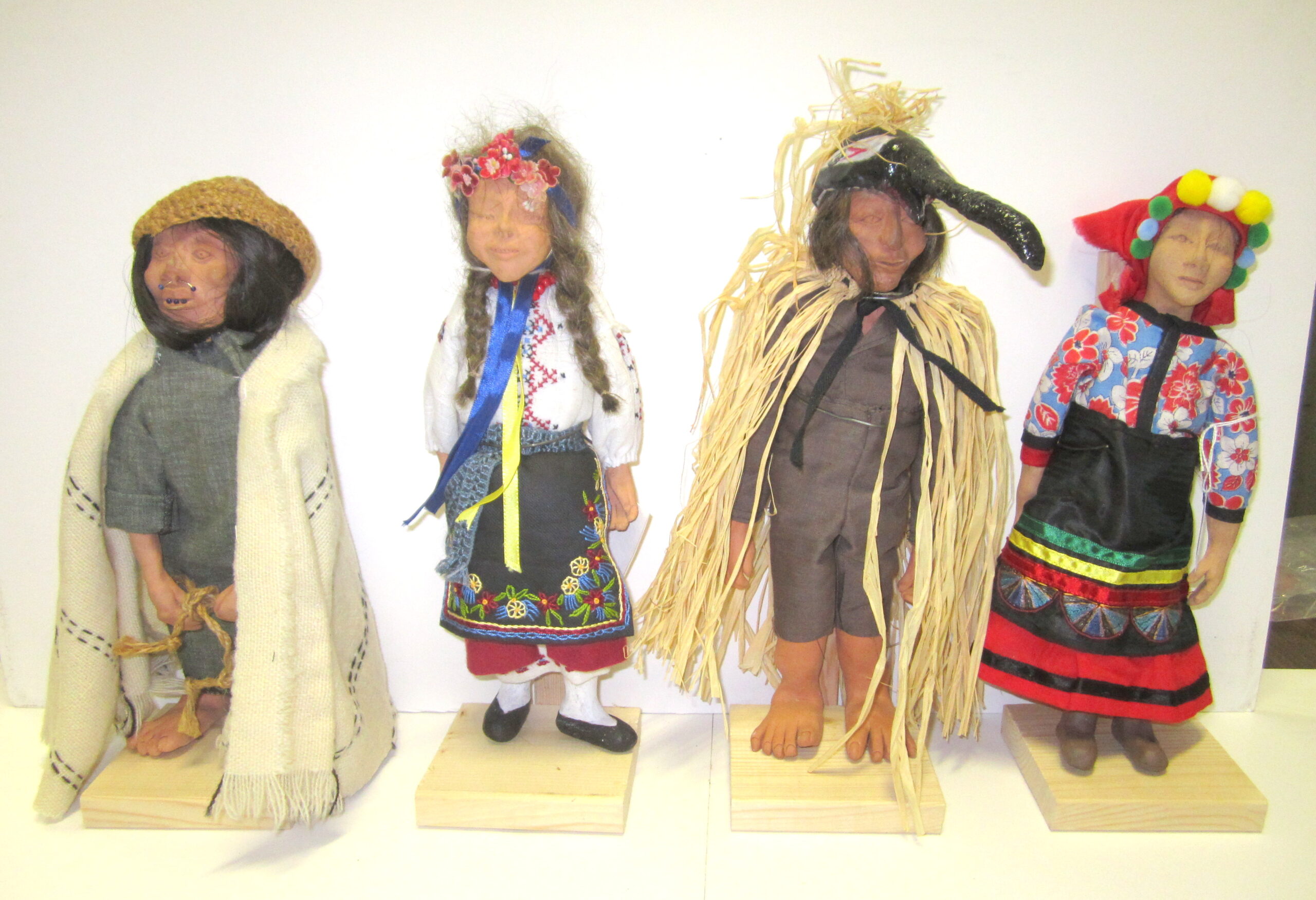
In the Sooke Region Museum’s artifact collection are 21 clay dolls, all wearing hand-made textiles, by Dorita Grant (nee Palin). Since August of 1982, Dorita has made dolls representing a variety of cultures and customs from around the world with a particular interest in Canada’s First Nations.
Dorita was born in Victoria in 1925 and raised in Oak Bay, where she now resides. Before she began making dolls, she earned a certificate in embroidery in 1967. Since then, she has taught embroidery at many locations including Camosun College. Dorita is an exceptional embroiderer and has been featured in numerous Canadian galleries and events. Her craft has also been included in publications such as Embroidery Canada Magazine (2006 and 2009) and the book Dolls of Canada.
Dorita’s doll making career began when she lived in East Sooke. One day, while playing with her grandkids, she made a single clay doll. This doll caught the eye of Elida Peers, who was the Director of the Sooke Region Museum at the time. When Dorita offered to make an exhibit for the museum, portraying a series of dolls that wore clothing representing a potlach celebration, Elida was delighted. This exchange with Elida inspired Dorita to continue doll making.
Dorita’s research on traditional potlach clothing took her to the Royal B.C. Museum where she read Captain James Cook’s journals from the 1700s. When reading these journals, she was captivated by Captain Cook’s description of Canada’s First Nations. In particular, many of her First Nations inspired dolls have oversized hands and feet because that is how they are described in the journals. Dorita was also inspired by colours and costumes she found in books.
There are several steps to constructing Dorita’s clay dolls. First, she molded the head and other body parts. In her notebook, Dorita has written “I take a piece of clay and make it egg shaped. I add a neck and shoulders and put it on a small wheel so I can look at it from all angles.” As she molded the faces of her dolls, she allowed the shapes and characteristics to develop naturally without using any specific methods. Before the clay dried, she carved an identification number on the back of the neck or bottom of the feet. Then she recorded the identification number in her notebook with the significance of the doll.
Next, Dorita sewed and embroidered the clothing. She used many fabrics, but preferred wool and cotton; Service men clothing found at thrift stores provided her with excellent quality wool. When trying to replicate cedar bark clothing, she often used jute.
As recorded in her notebook, Dorita says “the clothes are made as close to original as possible. I research the costumes and use colours and fabrics that resemble what was used originally. The hair [made from wigs] is the last to be done. Then a hat or scarf or ribbon finishes off the completed doll.”
When she first began making these dolls, the bodies were made from fabric and stuffed with cedar chips. Later, the doll bodies were made from wood which made standing and dressing them much easier. Her husband of 70 years, Marcus (or Mickey), made the wooden stands for the dolls.
Each of the 21 dolls in our collection has a different theme, many of which have sentimental value as they are some of the first dolls that Dorita crafted. These themes include Coast Salish clothing and celebrations, a preacher, a maid, the Ukranian dance dress, and the Hungarian folk dress.
Doll number 82.2 represents a First Nations woman as described by Captain Cook in his journals. The doll wears a traditional Coast Salish blanket and a long ankle length dress with pants underneath. She has shoulder length hair and wears a traditional cedar bark hat. Her face is adorned with a labaret and nose piercing. Her feet are oversized and her hands are holding braided cedar bark. Attached is a card with Dorita’s information, the doll number and theme. The doll is attached by wire to a wooden stand.
Doll 82.3.1 wears a traditional Ukrainian dance dress. The outfit consists of a blouse, a 3-tiered skirt, a necklace and a flower headpiece with long ribbons hanging down. The doll’s feet are painted to look like dance shoes and her hair is made into braided pigtails that cover the sides of her face. This doll also has an information card and wooden stand. Dorita was often inspired by dance costumes as she was once a dancer.
In 2012, at the age of 87, Dorita stopped making clay dolls, but she continues to make other types of fabric dolls and embroidery. In our gift shop, is one of Dorita’s clay dolls for sale; its name is “Sammy” and he wears a traditional Cowichan sweater. A couple of Dorita’s embroidered wall-hangings are also on display at the Monterey Recreation Centre in Victoria.

